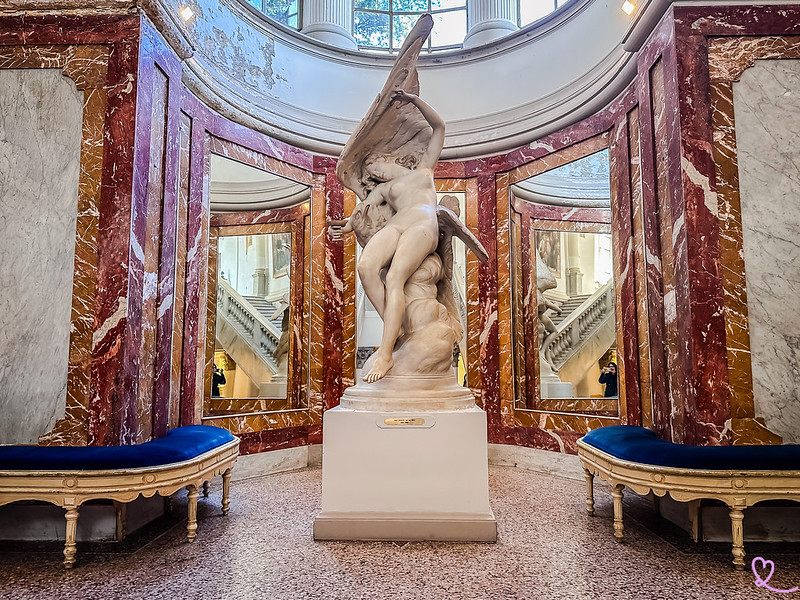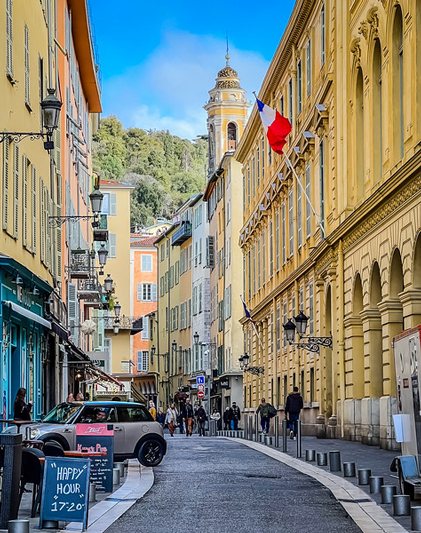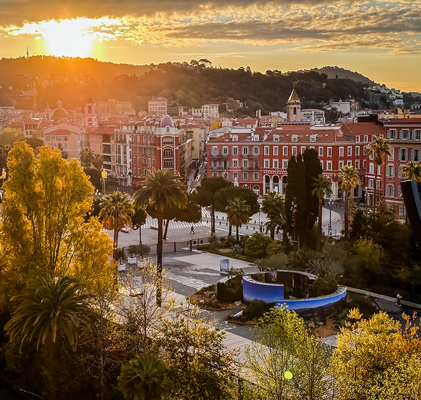If you’re planning a trip to Nice and are an art lover, be sure to visit the Museum of Fine Arts Jules Chéret. This splendid artistic oasis on the Côte d’ Azur (formerly Villa Kotchoubey) boasts a rich collection of masterpieces that testify to the elegance and refinement of the French Riviera.
Here are some useful tips for planning your visit to the Museum of Fine Arts in Nice.

This guide is completely independent, based on our experiences. We visited the region anonymously, making our own choices and paying our bills in full.
Is a visit to the Museum of Fine Arts worthwhile?
Yes, the Museum of Fine Arts of Nice is well worth a visit. We discovered a remarkable collection of works ranging from the Middle Ages to the 20th century. Impressionist paintings, neoclassical sculptures, contemporary or medieval works, all enchant the visitor. Temporary exhibitions add a fresh touch to this artistic immersion. An enriching cultural experience not to be missed!
In fact, we’ve included it in our suggested itinerary for art lovers to visit Nice in 7 days.
The 3-day Museum Pass, available on the official Ville de Nice website, gives you access to all Nice’s municipal museums for 72 hours.

What you can see
A monumental marble staircase

We were impressed by the monumental staircase leading to the first-floor hall. The magnificentglass roof houses a sculpture by Jean Coulon. On the walls of the second part of the staircase, four large paintings by Nicaise de Keyser benefit from natural light.

Sculptures from the 19th and 20th centuries

The Musée des Beaux-Arts de Nice collection comprises several thousand works. Each new exhibition is an opportunity to discover more. During our visit, behind Rodin’s famous Baiser, we were fascinated by the delicacy of Luigi Guglielmi’s Head of a Veiled Woman.
OUR TPS FOR RENTING YOUR CAR IN Provence
- Compare prices on our preferred platform: DiscoverCars – one of the best rated sites.
- Choose a car that is powerful enough (the roads are steep) but compact (some passages are narrow).
- Think of thecomplete insurance (some roads are tortuous and narrow).
- There is a lot of demand, book it early.

Paintings by the Barbizon School

We enjoyed rediscovering the naturalist themes of the Barbizon School painters. We were also surprised by those chosen by the women painters featured by the museum during our visit, such as Louise Bresleau and Marie Bashkirtseff. They are more interested in social reality.
Impressionist paintings

At the time of our visit, a temporary exhibition was devoted to the museum’s “Journey through the collections“. An opportunity to present Impressionist paintings by Eugène Boudin, Pierre Bonnard and a woman we’ve just discovered: Blanche-Augustine Camus.
Works by Raoul Dufy

The collection of works by Raoul Dufy is remarkable. Most of the paintings were bequeathed by his wife Émilienne in 1962. Between the depictions of the ports of Marseilles and Trouville, we liked to find the tawny colors of the Nude with a shell dating from 1933.
Representations of the Virgin Mary

The display in place at the time of our visit featured a selection of representations of the Virgin Mary from the 13th to 16th centuries. They attest to the importance of Marian devotion and theevolution of its iconography, in which the Virgin’s status as mother is gradually asserted.
La Belle Époque by Jules Chéret

One room is devoted entirely to the Belle Époque, with works by Jules Chéret (whose name the museum also bears). We learned that he was the inventor of the modernposter. The works on display, particularly the pastels, reminded us of the vintage Riviera posters still on display today.
Creations by Gustave-Adolphe Mossa

Another room is dedicated to the painter Gustave-Adolphe Mossa. A native of Nice, part of his work is part of the Symbolist movement. Her very 19th-century depictions of a femme fatale, both temptress and doom, appealed to us.
Paintings by French Orientalist painters

The museum’s main gallery is dedicated toOrientalism, an artistic and literary movement that profoundly influenced the 19th-century imagination. We particularly appreciated this spirit of travel andexoticism.
Masterpieces of Flemish painting

We really enjoyed this part of the museum, dedicated to the legacy of Aline-Odette Avigdor d’Acquaviva. Born into a Belgian family who had lived in Nice since the 17th century, this benefactress donated her family’s art collection to the city of Nice. These are paintings produced in Flanders and Holland between the 16th and 18th centuries.
Works by the Van Loo dynasty

In the main hall, we were able to enjoy the immense paintings by the Van Loo dynasty. The most illustrious, Carle Van Loo, born in Nice, was King Louis XV’s first painter.
We loved the magnificent Erard piano “forgotten” in this room. It dates from 1900 and was decorated by Albert Besnard and Alexandre Charpentier. It is still used today for concerts at the museum.
Museum of Fine Arts in Nice: how to get there
Where is the museum?
- In Nice
- On the heights of the Beaumettes district
- The museum entrance is at 33 Avenue des Beaumettes, Nice (06000).

Access by car and parking
Access by car is easy, but you may have trouble finding parking near the museum, especially during the summer months.
- At the time of our visit, there was a parking lot on the Avenue Auguste Renoir side, but it seems that it is no longer accessible to the public. Check the information on the official website here.
- Parking Indigo, 4 Rue de la Corderie (west, seaward), is a 20-minute walk away.

Public transport access
You have 2 options:
- By bus: line 38, Musée Chéret stop
- By streetcar: line 2, Centre Universitaire Méditerranéen (CUM) stop
Find out more here.

Visiting difficulties
The first floor of the museum is accessible to people with reduced mobility. There is no elevator to the upper floors. More info here.
HAVE FUN WITH THESE activities
- Great kayak trips in:
Saint-Tropez to the Ramatuelle reserve
Cassis to the calanques - Helicopter flight from Cannes
- Shuttle service along the coast between Nice and Saint-Tropez
- Bike tours: eBike in Nice – Mountain biking in the Esterel massif

Useful tips for visiting the Museum of Fine Arts
Schedules and prices
The museum is open every day except Monday and certain public holidays (January 1, Easter Sunday, May 1, December 25):
- 11 a.m. to 6 p.m. November 1 to April 30
- 10 a.m. to 6 p.m. May 2 to October 31
- Price: €10
- Free for children under 18
See the latest news on the official websitehere.

How long
Allow around 1 hour to visit the Musée des Beaux-Arts Jules Chéret in Nice.
Best moment
We advise you to come in the morning if you want to enjoy the visit in peace and quiet. However, on hot days, the coolness of the museum is much appreciated.
Direction of visit
There was no sense of direction when we came to explore the museum spaces. We started with the first floor, but you can do the opposite.

Visiting with children
We didn’t see any specific courses for children.
Eating out
The museum is located near Nice city center. Take advantage of the Côte d’Azur’s many restaurants. Don’t miss our article on the best places to eat in Nice.

Hotels
The museum is located in Nice. You’ll find plenty of hotels nearby. In fact, we’ve devoted an article to our top places to stay in Nice.

We stayed at the Anantara Plaza Hotel, overlooking the sea. See prices, photos and availability.
DISCOVER Nice
- Best things to do in Nice
- Where to stay in Nice: 15 best hotels
- Where to eat in Nice: 20 best restaurants
- The 12 best museums in Nice
- Best beaches
- Visit the Palais Lascaris
- Visit the MAMAC Museum
- Visit the Museum of Photography
- Itineraries: 1 day – 2 days – 3 days – 5 days – 7 days
- Rent a car in Nice (airport or train station)
- Most beautiful villages around Nice




